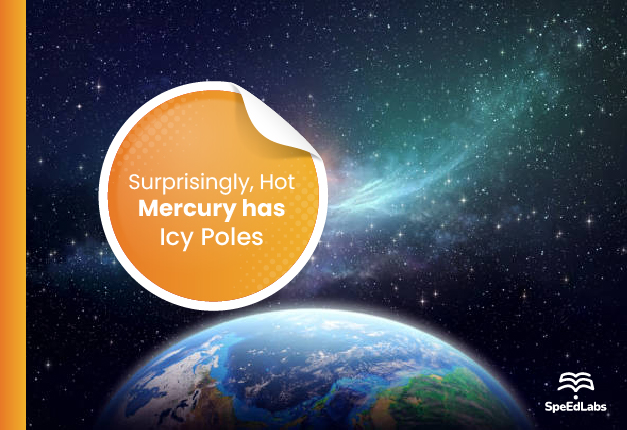Mercury is the hottest planet in the solar system as it is the nearest to the Sun. If I ask you, “Can there be a single trace of ice on this planet?” Your answer will be no! But, this answer will be wrong! Keep on reading to know-how.
Mercury is a planet with many extremes. Near the equator, the daytime temperature on the planet closest to the sun can reach 400 degrees Celsius, which is hot enough to melt lead. When night falls, the planet’s surface temperature drops to below –150 degrees Celsius.
However, some areas on Mercury are slightly more stable.
On the dim planet, regions inside polar craters never see the light of day, shaded as they are by the craters’ rims. Throughout the Mercury day, the temperature remains cold. New data from NASA’s MESSENGER satellite, presented in March at the annual Lunar and Planetary Science Conference, back up a long-held theory that Mercury has hidden pockets of water ice in those shadowy craters despite its proximity to the sun.
Since 2011, the MESSENGER spacecraft has orbited Mercury, mapping its surface in unprecedented detail. MESSENGER’s polar crater maps match up well with earlier Earth-based radar imagery of the poles, which revealed anomalously bright features—patches that reflected radio waves much better than the surrounding terrain, much like ice does.
Smaller craters and those at lower latitudes, which would have less ice-friendly temperatures across the crater floor, are also lined by radar hotspots. To prevent sublimation, these ice deposits would most likely require a thin insulating blanket, such as a layer of fine-grained surface material, or regolith.
The data from MESSENGER appear to confirm that some sort of insulating material blankets whatever ice may be lining the craters. According to David Paige of the University of California, Los Angeles, the temperatures inside the shadowed craters are ideal for ice deposits blanketed by regolith darkened by organic compounds.
What is the chemistry behind this?
The new study of features discovered by Earth-based radars over a decade ago “fairly conclusively” shows that they are “primarily composed of thermally stable water ice.”
Hydroxyl Groups (OH) are formed primarily by protons and are found in minerals in Mercury’s surface soil. The extreme heat in the model helps to free up the hydroxyl groups, which are then energised to smash into each other, resulting in water molecules and hydrogen that lift off the surface and drift around the planet.
Some water molecules are broken down by sunlight or rise high above Mercury’s surface, but others land near the planet’s poles in the permanent shadows of craters that protect the ice from the sun. Because Mercury lacks an atmosphere and thus no air to conduct heat, the molecules become part of the permanent glacial ice that is kept hidden in the shadows.
“It reminds me of the song Hotel California.” “Water molecules can check into the shadows, but they can never leave,” said Thomas Orlando, the study’s principal investigator and a professor in Georgia Tech’s School of Chemistry and Biochemistry. The Georgia Tech Center for Space Technology and Research was co-founded by Orlando.
“For about 3 million years, we postulate that 1013 kilograms (10,000,000,000,000 kg or 11,023,110,000 tonnes) would become ice,” Jones said. “It’s possible that the process could account for up to 10% of Mercury’s total ice.”
On Monday, March 16, 2020, the researchers published their findings in Astrophysical Journal Letters. NASA’s Solar System Exploration Research Virtual Institute (SSERVI) and NASA’s Planetary Atmospheres programmes funded the study
Also published on Medium.
